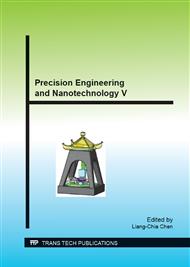p.689
p.695
p.700
p.706
p.712
p.717
p.722
p.728
p.736
Study of Mechanism for Wear Adjustment with Electro Wedge Brake
Abstract:
Electro wedge brake (EWB) have been suggested and improved for enhancing the braking efficiency and reducing the weight and power of actuating motor than electro mechanical brake (EMB). This is due to self-reinforcement features of the wedge mechanism. On the other hand, the conventional hydraulic brake system has the passive wear adjustment without any sensors and actuators. This is because of the sealing rubber which is disposed between the hydraulic cylinder and piston, and supply the piston’s same restoring strokes regardless of pad’s wear amounts. This feature leads to the uniform distance between the disc and the pad. In comparison, electronic brake systems such as EMB and EWB don’t have the hydraulic piston and cylinder with the sealing rubber. Therefore the electronic brake systems cannot use the function of this passive wear adjustment. However, if the electronic brake system has gap sensors for detecting distances between the pad and the disc, and actuators for keeping the uniform distances between the pad and the disc, then the brake system can have the function of wear adjustments. One of our research goals is the embodiment of cost-effective and feasible wear adjustment mechanism which is proper to EWB. In this paper, as a chain of EWB’s development, we describe the proposed mechanism for wear adjustment with EWB. Further we describe the feasibility of this mechanism with the simulation study.
Info:
Periodical:
Pages:
712-716
Citation:
Online since:
August 2014
Authors:
Price:
Сopyright:
© 2015 Trans Tech Publications Ltd. All Rights Reserved
Share:
Citation:


